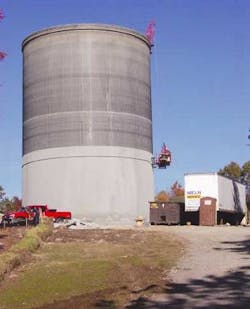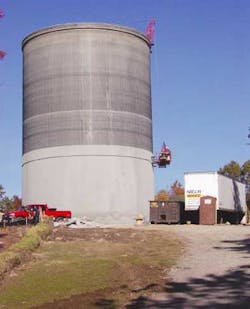Concrete Standpipe Reaches New Heights
In early 2002, the Town of Norfolk, MA, prompted by the completion of a significant new residential sub-division, and the need to repaint an existing steel water tank which could not be taken out of service, determined that additional potable water storage capacity was needed to adequately meet the needs of the town.
The consulting engineering firm of Dufresne-Henry, Inc., Westford, MA, was commissioned to evaluate the town's water system and make recommendations. Previous experience with all types of water storage tanks led Dufresne-Henry to recommend a prestressed concrete tank based on competitive initial cost, zero scheduled maintenance, siting flexibility, uninterrupted service over the life of the tank (projected to be a minimum of 50 years) and lower life cycle costs.
However, due to the elevation of the available site and the hydraulic requirements for the town water system, Dufresne-Henry determined that a 1.1 million gallon tank, 50' in diameter with a water depth of 75' would be required. This configuration is normally referred to as a standpipe (defined as a water storage tank where the water depth is greater than the tank diameter), which in the past has normally been constructed as a steel tank.
Dufresne-Henry approached Natgun Corp. of Wakefield, MA, a company that specializes exclusively in the design and construction of precast, prestressed concrete tanks built to the AWWA design standard consistent with Dufresne-Henry's recommendations.
Based on discussion with Natgun concerning the feasibility of constructing a tall, prestressed concrete standpipe, Dufresne-Henry recommended a maintenance-free prestressed concrete tank to the Town of Norfolk.
In evaluating the project, Natgun conducted both technical and construction feasibility studies, made siting suggestions to optimize tank performance and minimize tank cost and supplied design drawings for review by Dufresne-Henry and the Town of Norfolk.
They reviewed the requirements of AWWA Standard D110, Type III, which requires that precast concrete wall panels and the steel diaphragm embedded in the wall panel be continuous for the entire sidewall height of the tank. Until now, these have been limiting factors in the height of prestressed concrete tanks, in that they necessitate the need to efficiently transport diaphragm materials to the site in one piece (75'-7'' long), and pre-cast and erect very large, very heavy wall panels.
Natgun overcame these limitations by developing transportation and lifting systems to construct tanks 75 feet tall and greater.
Another factor that has limited the height versus diameter of prestressed concrete tanks has been the availability of a machine to efficiently apply wire wound prestressing to the core wall of a tank with a sharp radius (small diameter) and height greater than 60 feet. Again, Natgun solved the problem by developing a prestressing machine suspended from the dome of the tank that rides on the wall to provide the application of accurate prestressing force at the tight radiuses and height indicated.
Norfolk accepted Dufresne-Henry's recommendation to construct a wire wound prestressed concrete tank and advertised the project on June 28, 2002. Sealed bids were opened and Natgun was the low bidder and was awarded the construction contract.
During design and construction, Natgun gave special consideration to the tank foundation and floor wall connection design. The flexible floor/wall connection, which is designed to reduce bending moments in the wall, was constructed with seismic cables embedded in the floor and wall to resist seismic loads, wind loads and overturning forces. The floor was a monolithically placed 16'' reinforced concrete floor.
Each of the 13 precast panels used in the Norfolk tank weighed approximately 34 tons. This created a load on each panel during erection substantially greater than the load would be once the tank was in service, which required a balanced eight point lifting system.
Once all tank wall panels were erected and placed, slots between the wall panels were filled using a 10-gauge steel plate bonded to the exterior of the steel diaphragm with a polysulfide sealant. The vertical slots were then filled to the height of the tank using a high-strength mortar mix with no cold joints.
As is the standard for most prestressed concrete tanks built by Natgun, the Norfolk tank was constructed with a free-standing concrete dome roof using 12 precast concrete dome panels. Each panel weighs 5 1/2 tons and was temporarily supported on a steel shoring system during construction. Once the dome slots were filled with concrete, prestress wire was applied to the dome ring, putting the dome into permanent compression and providing for a free-standing dome roof.
The steel diaphragm on the exterior wall was covered with a layer of shotcrete to protect against corrosion, and the tank wall was prestressed with approximately 395,000 linear feet of prestress wire.
Upon completion of prestressing operations, a cover coat was placed over the last layer of shotcrete, providing a high lime, high PH environment, and eliminating the potential for corrosion.
Tank construction began Sept. 8, 2002, and was completed in late November 2002. After the completion of site work the tank was tested and put in service in the spring of 2003. The town was then able to take its existing steel water storage tank off line for much needed painting.

